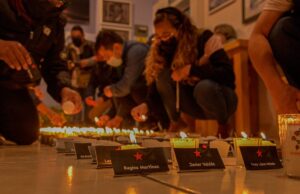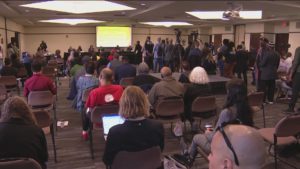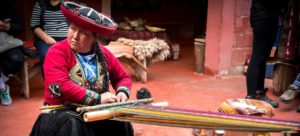University staffers were searching for missing Native American artifacts. They found dozens of dead bodies.
Last winter, University of North Dakota English professor Crystal Alberts started searching for a missing pipe, a headdress and moccasins once on display at the school’s library, heading deep into the recesses of the nearly 140-year-old campus.
The collection was removed from the library in 1988, after students questioned whether the university should be showcasing objects of religious significance to Native Americans. Alberts, a colleague and her assistant searched in back rooms and storage closets, opening unmarked cardboard boxes.
Inside one of them, Alberts spotted the pipe. The assistant reached for it, she said.
“Don’t touch it,” Alberts recalls saying.
She called Laine Lyons, a member of the Turtle Mountain Band of Chippewa Indians who works for the UND Alumni Association and Foundation, and asked for help.
Lyons met with Alberts to offer advice on how to respectfully handle the items, watching as Alberts and her colleagues opened box after box. Lyons said she now feels naive thinking back on it, but she never expected what they found: more than 70 samples of human remains, many of them in boxes with no identifying information.
“The best way I can describe how we have found things is in the most inhumane way possible,” Lyons said. “Just completely disregarded that these were once people.”
She said it sunk in: Her university had failed to treat Native American remains with dignity and repatriate them to tribes, as required by federal law.
“In that moment,” she said, “we were another institution that didn’t do the right thing.”
As soon as the bodies were discovered, UND President Andrew Armacost said administrators reached out to tribes — at first a half-dozen and now 13 — to start the process of returning the remains and more than 100 religious objects.
Morning Rundown
Get a head start with the latest breaking news and must-read articles from NBC News.
“What we’ve done as a university is terrible, and I will continue to apologize for it,” Armacost said in a Wednesday news conference, where he vowed to see every item and ancestor found to be returned to the proper tribal nation.
But that process will likely prove daunting and could take years — and in some cases, may be impossible because of the dearth of information, Lyons said.
“I have fears that maybe we won’t be able to identify people or maybe we won’t be able to place them back where they should be placed,” she said.
Since the passage of the Native American Graves Protection and Repatriation Act (NAGPRA) in 1990, federal law has required institutions that receive federal funding to catalog their collections with the National Parks Service and work toward returning them to the tribal nations they were taken from. But the University of North Dakota has no entries in the federal inventory, even though its administrators acknowledge it has possessed Indigenous artifacts since its inception in 1883.
The discovery at UND is illustrative of a wider, systemic problem that has plagued Indigenous communities for centuries. Despite the decades-old law, more than 100,000 are still housed in institutions across the country. The action and apology by North Dakota administrators points to a national reckoning as tribal nations are increasing pressure on public universities, museums and even libraries to comply with the law and catalog and return the Native American ancestors and cultural items in their possession.
“We are heartbroken by the deeply insensitive treatment of these indigenous ancestral remains and artifacts and extend our deepest apologies to the sovereign tribal nations in North Dakota and beyond,” North Dakota Gov. Doug Burgum said in a statement. “This dark chapter, while extremely hurtful, also presents an opportunity to enhance our understanding and respect for indigenous cultures and to become a model for the nation by conducting this process with the utmost deference to the wishes, customs and traditions of tribal nations.”
Armacost said he and his colleagues decided to honor the requests of tribal officials not to announce the discovery until a consensus could be built on how to handle the remains, and until Indigenous faculty, staff and students could be made aware of the situation in a respectful way.
Tribal officials and Indigenous archivists said that UND leaders should be commended for how they’ve responded, praising Armacost’s willingness to consult tribes immediately after the discovery and publicly apologize for the university’s failings. But they also called for accountability.
“It is always extremely traumatic and hurtful when our ancestors remains have been disturbed and misplaced,” Mark Fox, chairman of the Mandan, Hidatsa, Arikara Nation, said in a statement to NBC News. “We will be monitoring this matter closely to ensure that our ancestor’s remains are repatriated as quickly and as respectfully as possible under the circumstances.”
Many universities and museums have NAGPRA officers on staff who inventory Indigenous remains and cultural items, affiliate them with their tribes of origin, and eventually return them. However, UND does not have its own NAGPRA office. The university has appointed a committee to review the findings, and Armacost told NBC News that hiring staff to facilitate NAGPRA cases is under consideration.
Dianne Derosiers, a historic preservation officer for the Sisseton Wahpeton Oyate, a tribal nation in North Dakota, said she wants to know who is responsible for unceremoniously locking away the human remains in university storage. “I’d like answers to that question,” she said.
Armacost said that finding out who is accountable will be part of the university’s investigation.
Lyons said she hopes UND’s discovery will be a wake-up call to other institutions that are dragging their feet when it comes to compliance with NAGPRA.
“Look at what you have, look at your past,” she said. “And if you know something, you need to say it and not hide it and not pass it off and wait for someone else to do it. You need to confront that right away.”




